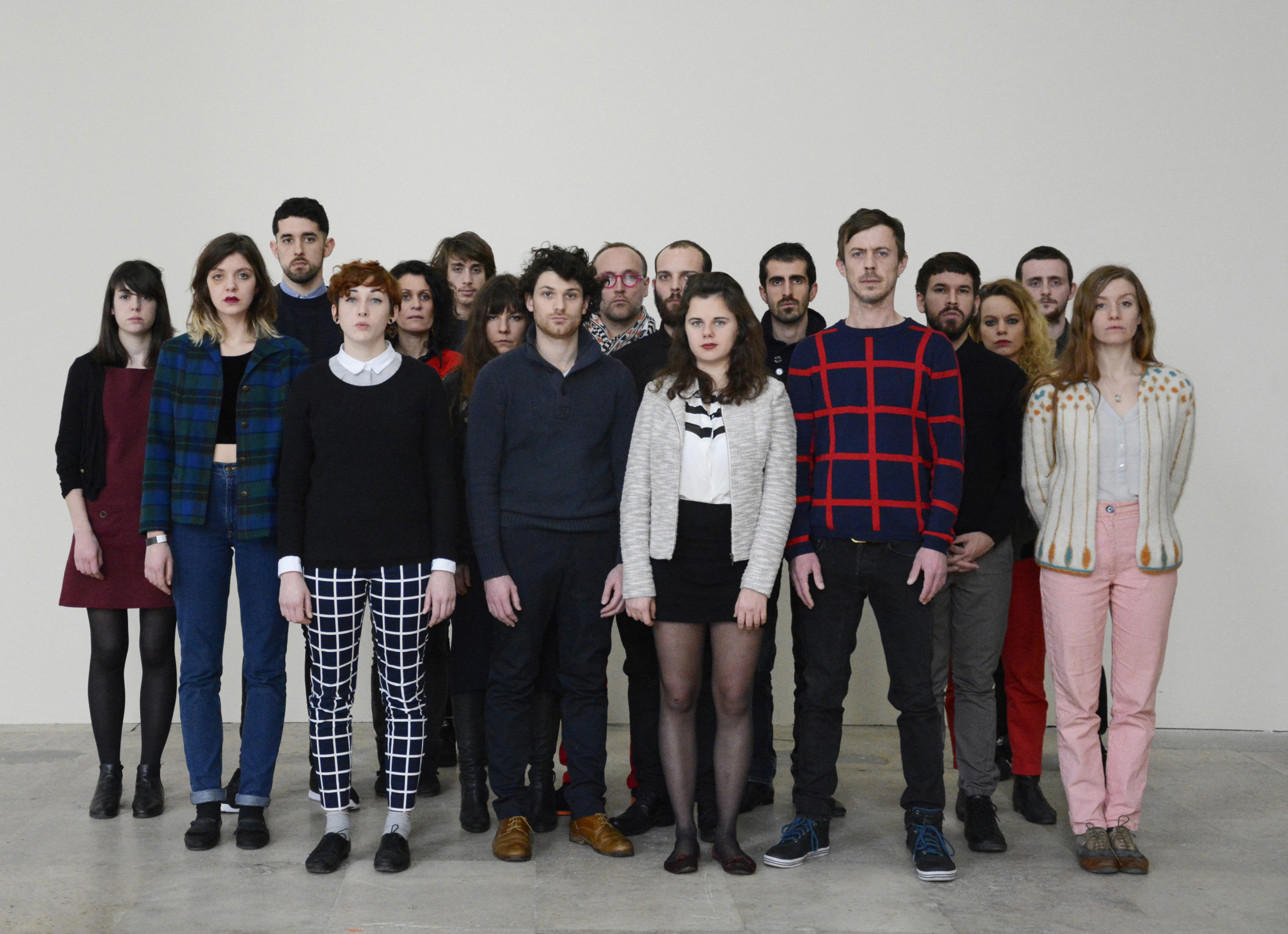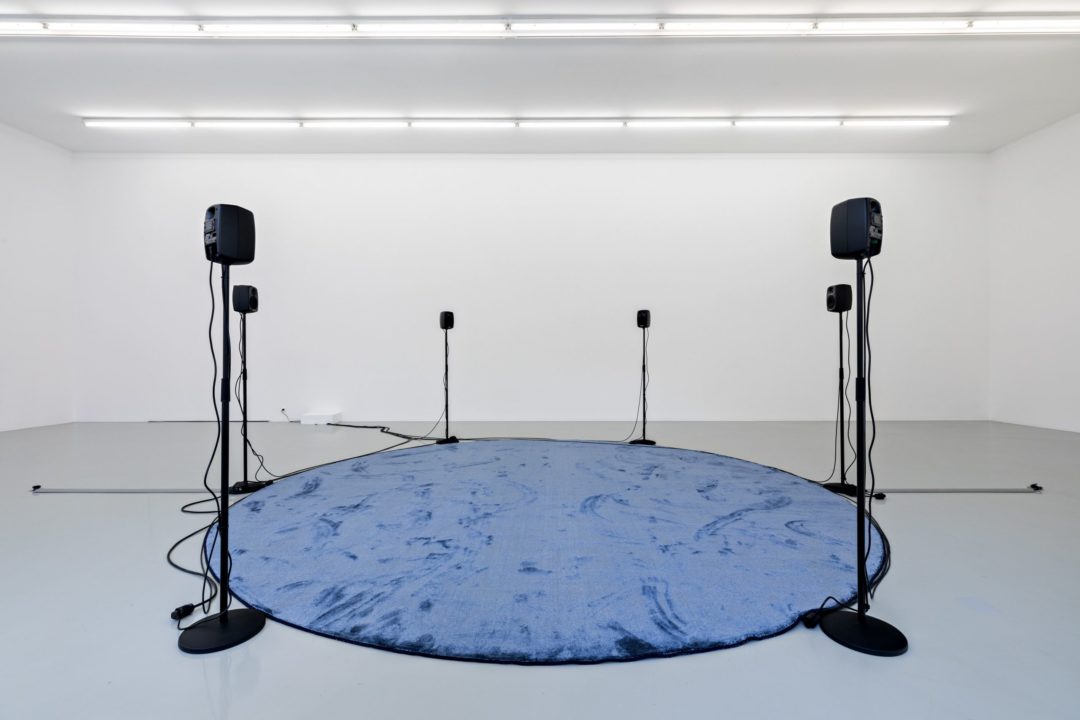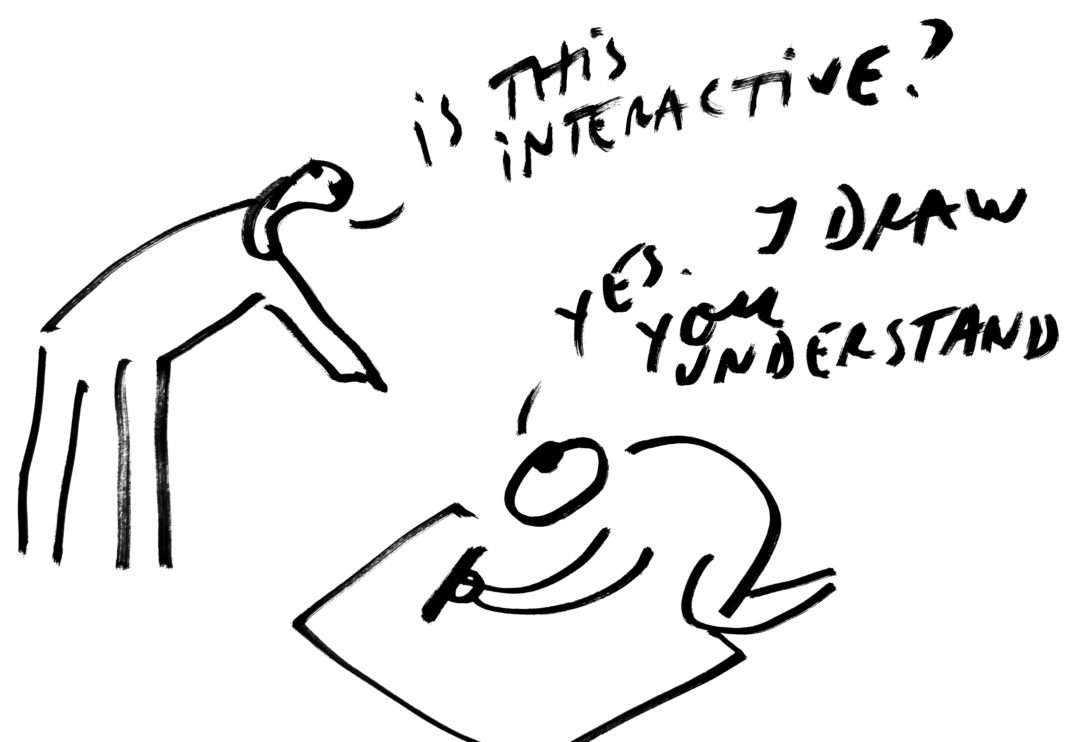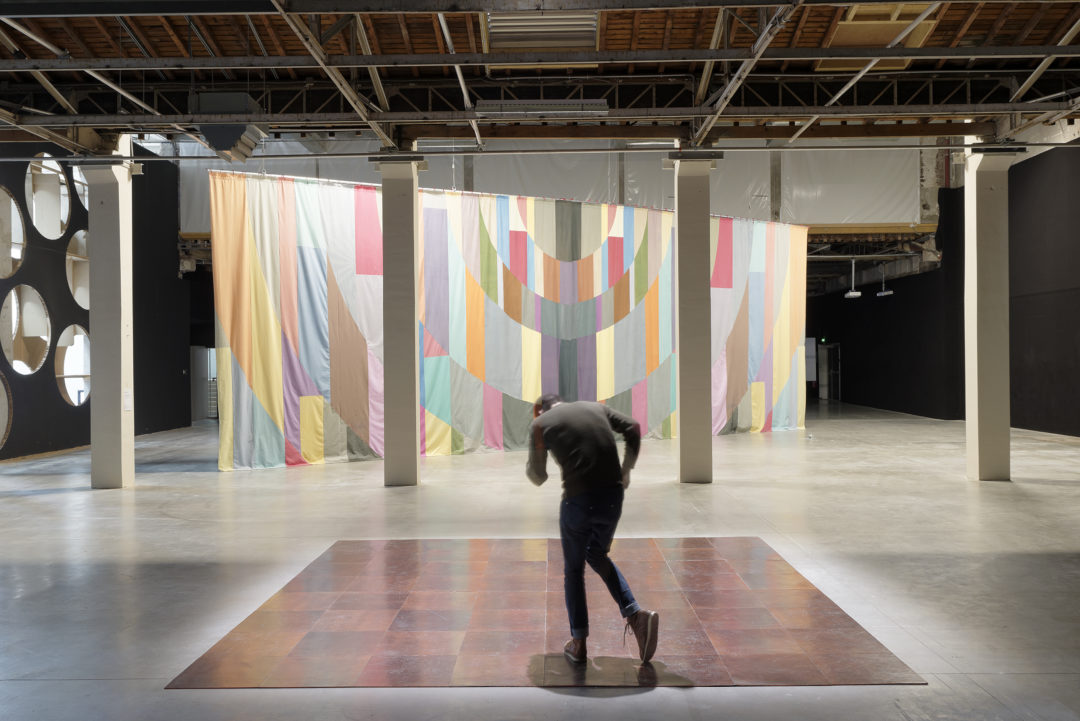Exhibition-Making as Practice (A Journey)

After three years of health measures and political and environmental injunctions, society as a whole emerged in a metamorphosed state, making this writing project a necessity. The deck had been shuffled and new hands were distributed. A new epidemic and societal theatre caused profound upheaval within communities. Our relationship to the world—along with interrelated societal and contextual ties—and to its structure (in other words the framework, and also the system) had changed; today’s society can no longer be constituted, we can no longer exist in the same ways we once did in the existence we now inhabit. From protocols put in place restricting the way we are allowed to circulate in public spaces, our self-expression or the choices we make, to protocols-based art shows, we are left with precious little leeway. When exhibitions mirror a world whose critical scope has been so greatly diminished by a sensationalist media, its agenda set by governments; where within digital spaces which have been colonised by private interests all decisions are algorithm-based, what can we possibly hope to gain within the cultural milieu today? What can we learn from its narratives? What kind of experience can we expect to access when faced with an artwork, that we haven’t already had? Why “do exhibitions” (as in to see, as well as to make) today? In the aftermath of Covid-19 closures, raising attendance figures amongst an ever-changing visitor demographic became imperative for art institutions. Re-openings were led by a general sense of urgency to be attractive. The race to boost attendance had a pronounced impact on visitation. Some have viewed the contexts in which we now encounter artworks as veering uncomfortably close to the domain of the spectacle, to attain the level of mere entertainment (emotional, immersive, participatory trends), one which aims to make the finite quality of our existence easier to bear (as the most recent IPCC report has attested). Contrastingly, diligence is required by some institutions which reduce visits to a strictly delimited time slot (during which visitors are steered through exhibitions on a unidirectional path, with a predetermined visit imposed, wall texts, etc.). What symbolic agency can we expect to have when a given experience has been reduced to mere spectacle or its entertainment value? Or when it takes on the quality of a straightforward mode of communication? When it serves as a platform for knowledge and ideas which are presented as unchanging and unquestionable? Lastly, why create anything new at all, when this particular materiality may no longer be suited to our contemporary sensibilities?

Over the last twenty-five years, my work as a curator of contemporary art has led me to consider impermanence as a tool for emancipation. This work, whose practical method can be referred to as a “literature of terrain,” is a literature in which facts are established and analysed through their inquiry and the association of ideas, rather than through an objective, scientific and closed process. Instead of exercising a deterministic method, it opens up a dialogue. Sociologist Michel de Certeau suggests, as a daily practice, that we might abandon ourselves to a “school of life brand of freedom in practices”: a type of freedom through which each individual might seek to become a homogenising force within society. It is in this very spirit that I pen this essay, which situates itself at the crossroads between the study of exhibition practices, the social sciences and literature. Its subjectivity is susceptible to induce a coexistence with the reader within the text, as is also the case with exhibitions, seeing as this essay will take the form of a guided tour, wall text at the entrance and exit included.
The 1997 exhibition Sensation at the Royal Academy of Arts in London was my first encounter with the contemporary arts. This was the Young British Artists’—as they later became known—grand entrance, complete with a tailored marketing campaign. Everything including the title was grandiose. The press reported excitedly about content-adjacent events like the egg thrown at a Marcus Harvey work—a portrait depicting a woman who had been accused of infanticide. This act committed by a visitor to the exhibition was almost performative itself, and seemed like a natural accompaniment to the overtly transgressive intentions of the works. The spectacular quality of the exhibition had provided the backdrop for another spectacle. Which leads us to the question of who sets the stage along with its limits?
The avant-gardes—namely Allan Kaprow, Bertold Brecht and Antonin Artaud on the stage—all experimented with breaking down the barriers between the actors and their audience, theorising on how to incite audience members to participate. In Brechtian drama, emphasis is on process rather than results. The objective is for the actors to adopt certain attitudes, rather than to generate a product destined for consumption. The playwright went as far as to distribute audience feedback forms at the end of performances, in order to adapt his plays if necessary. Exhibitions in the 21st century seem nonetheless to have gotten sucked into the Tik-Tok era: wherein the spectacle on offer must be relatable, effective and brief, so as to not be erased by another. While some institutions might, contrastingly, afford the visitor a large measure of freedom in terms of how they move through exhibition spaces, they accompany this liberty of movement with a host of signs and explanatory texts, lending a Twister board-game-like quality to exhibitions (with circles and arrows and other indicators on the floor). An accepted amount of “guided freedom” becomes a more or less imposed trajectory, in everyday life as well as on a symbolic level. An environment in which every available orientation is spelled out for us deprives us of the unexpected. What type of visitor experience are we meant to offer and experiment with, whose practice might be emancipatory in nature, whose processes and procedures would be sustainable?
My hypotheses have been developed so that they resemble the exhibition format—in other words in a spirit of openness and limitless interpretations. In his book Notes On Literature, philosopher and social critic Theodor Adorno positions language in such a way that it echoes artistic creation, showing how the essay holds space for fragmentation, subjectivity, open contours. If we were to consider exhibition procedures in light of this text, we might come under the impression that everything has been dismounted up until the moment when the ensemble comes together. Gathering together a scattered sort of writing, produced on the principal of a curator who is always on the move, an exhibition of this sort would be more invested in producing a reflexive terrain than in responding to an ideology or a decisive truth. This exercise would reference that of an artistic production in the form of a “wish to write”, an occasion for ideas to circulate. Artists who are involved in these types of inquiries about phenomenology and experience as they relate to capitalism (Carole Douillard, Dora Garcia, Cécile Paris, Nina Beier & Marie Lund, as well as Hanne Lippard, Christian Jankowski, Aurélie Haberey, Dan Perjowski…) approach the exhibition as a “co-incidence” as well as a medium which engages a telescoping with the world and with oneself. Written at a time when the concept of individuation has been replaced by individualistic attitudes modelled on social media, this text, like a gathering of artworks, hopes to forge a connection with readers who are open to peruse it using “ordinary language” In addition, given that exhibitions are reflective surfaces, in both accepted senses of the term (they are both mirror and generator of ideas), this essay will focus mainly on personal experiences and case studies. A built vagabondage, the textual construction site is what characterises this essay, whose shortcomings allow it to attest to the way that text, exhibitions and life are interrelated.

In what is known as “practical” philosophical thought, and in the work of Aristotle in particular, human actions and activities should somehow be related to their personal development and social well-being. The omnipresence of interactivity in today’s society (solicitations for feedback, for participation, etc.) is also a feature of the art world. Otherness as an active ingredient in the effort to diversify audiences should of course be taken into account. Immersive and interactive exhibitions should be considered as being related to the types of venues possessing an adequate economy for these types of formats. The spectacular nature of digital communication and self-staging has become a high point of ticketing—high volume sales of entrance tickets to certain venues which sometimes no longer feature artworks at all. In this scenario, the measure of a successful exhibition is that of high visitor traffic instead of any eventual repercussions on the artists’ trajectories or effects on audiences’ education. In order to attract audiences, sensations need to be elicited (as in “sensational”, unrelated to the mundane, creating unforgettable sensations or emotions). Democracies worldwide are now being confronted by widespread nationalism which thrives on “big emotions” like fear or disgust; these same dynamics are present—albeit to varying degrees—within exhibition display practices. This shift, which has given way to variations in exhibition formats or to museums with no artwork on view (Atelier des Lumières, The Museum of Illusion, The Selfie Museum…), illustrates what we may refer to as a “narcissism of proof”, one which strategically implicates us as actors in a situation which itself consists of narcissistic mirroring. The myth of Narcissus, whose name comes from the greek narkê, or“sleep”, tells the story of the construction of the self via metamorphosis, including that of the reflection (or the selfie). Contrastingly, Allan Kaprow’s much-cited everyday life belies the little notoriety the artist expected to recieve. Ignored as he was by art critics of the day, Kaprow made use of a double, or “false self”, with which he critiqueed himself.
Self-Service (1996) is a Happening which was “made for three cities (New York, Boston and Los Angeles) taking place over the course of four months, from June to September, whose activities will occur within those of the normal lives of participants. They do not necessarily need to be coordinated.” The actions are short (such as yelling in the metro before exiting) and discreet (to remain on a bridge until two hundred cars have passed). They integrate themselves into an existing environment which becomes subtly altered. “The events develop in a concentrated and very theatrical way toward simplicity and ordinariness, where they get mixed up and melt into everyday activities,” Kaprow explained to Pierre Restany in a letter. Without spectators, there could be no spectacle and the happening became a simple “activity.”
Art venues attempting to cast as wide a net as possible in terms of audience participation take the risk of homogenisation if they attract visitors using emotional, interactive or sensorial methods, via technology. The monumental is a function of the privileged. What we might call exhibitainment (a contraction of exhibition and entertainment) creates an organic situation of contemplativeness and inwardly-focussed behaviour (“the more they contemplate the less they live,” Guy Debord wrote with reference to the viewer who has become alienated from the object they are examining.)
In contrast to the accumulation of objects and technologies, the economic production enabled by the exhibition of relational and non-spectacular works of art is related to the liberty of immersive models. This type of exhibition hinges upon a principal of emerging forms, ideas and affects; its audience is considered a salient element in a system which is larger than itself. Here, audience members encounter works in which they discover something about themselves, sometimes a part they had yet to formulate. In Lewis Carroll’s story, Alice finds herself in a store where the objects disappear progressively as they appear, as if sight, once it has something in view, had the power to erase all materiality—a way of showing us our individual capacity to erase that which is not relevant to us.
As we shift from an economy of possession to an economy of use, we might ask ourselves how we can redirect our focus to doing exhibitions differently. With or without newly-produced objects, the system we are now seeing confronts us with the experience of having to generate events. There is movement, activity. “In the work of John Dewey, the pragmatic attitude is seen as the opposite of the speculative theory of knowledge. To know is not to see (…) but to act.”
Dewey had already introduced the idea of a democratic and scientific development of individual production and collective organisation by members of society. In other words, a way of living which is based on agency. Scholar and activist bell hooks, who associates empathy and mindfulness with social inequality, writes about the need to create space within society not simply for safety (the safe space, a non-violent place) but also primarily for encouragement. In this type of place, we would be invited to speak out and to act, each in our own individual way. This free space would exist apart from the monumentality of all type of governance. Instead of a sign of authority, like the public monument, this type of place could represent a new foundation. This brave space would enjoin the pressing need for all to participate, in order to validate the liveability and sustainability of a décor in which we are no longer considered in first place.
Essay to be featured in a forthcoming issue of MIX
www.editions-mix.com

1 Writer and critic Dominique Viart defines this as a practice which combines the social sciences with literature, in which the writer introduces facts through inquiry, as opposed to presenting them as factual truths.
2 Michel de Certeau, L’invention du quotidien. Arts de faire, tome I, Gallimard, 1980 (First edition).
3 Which is to say produced and shown simultaneously, during the same time period.
4 For the playwright, spontaneity is more important than artificiality and spectacle.
5 Architect Philippe Pumain has used this term to indicate an ideal exhibition design.
6 Umberto Eco, « L’œuvre d’art est un message fondamentalement ambigu, une pluralité de signifiés qui coexistent en un seul signifiant », in L’œuvre ouverte, 1962.
7 Theodor Adorno, « L’essai comme forme », in Notes sur la littérature, Suhrkamp Verlag, 1958.
8 Roland Barthes, « De la rencontre de quelques textes lus naît l’“Espoir d’écrire” », in La préparation du roman. Cours au Collège de France (1978-1979 et 1979-1980), Seuil, 2003.
9 Occuring at once within the space, within the assembled works and amongst the audience.
10 Gilbert Simondon has stated « The individual is not simply one (unit, totality), they are unique (unicity, singularity). An individual is more of a verb than a substantive, a process as opposed to a state, a relationship instead of a term and that is why it is more appropriate to refer to individuation rather than to an individual», in L’individuation à la lumière des notions de forme et d’information, Jérôme Millon, 2005. Voir : https://arsindustrialis.org/individuation#sdfootnote1sym
11 See Ludwig Wittgenstein, Philosophical Investigations, Oxford Blackwell, 1976.
12 See Eva Illouz, Les émotions contre la démocratie, Premier Parallèle, 2023.
13 Proof, testimony.
14 The supposed art critic, a colleague of the American artist, Theodore Tucker, wrote in The Village Voice (a New York-based publication) : « I must admit that Mr. Kaprow’s art is problematic. […] The life of an exhibition can only exist in the present, and all that will be left behind are memories. » Theodore Tucker however is a pseudonym, these words on Kaprow come from Kaprow himself, and create a link between reality and fiction.
15 See the writing of Pierre Saurisse, « Allan Kaprow en 1964 : la mue du Happening », dans Critique d’art, no 30, 2007.
Url : https://www.archivesdelacritiquedart.org/wp-content/uploads/2016/12/Dossier_Archives_30.pdf
16 Translator’s note : In the original French “exposition et entertainement”
17 Guy Debord, Œuvres, Gallimard, coll. « Quarto », 2006.
18 See Jean Foucard’s essay on William James,, « Pragmatisme et transaction. La perspective de John Dewey », in Pensée plurielle, no 33-34, 2013, pp. 73-84. Url : https://www.cairn.info/revue-pensee-plurielle-2013-2-page-73.htm.
19 With regard to people belonging to a minority group, a term which originated from the LGBTQI+ movement and was adopted by academics and other educational milieux.
______________________________________________________________________________
Head image : The Viewers, 2014, Palais de Tokyo, Paris (FR) Collection Centre National des Arts Plastiques Photos : Carole Douillard & ADAGP (titre de l’expo : Des choses en moins, des choses en plus, cur. Agnès Violeau et Sébastien Faucon)
Related articles
Toucher l’insensé
by Juliette Belleret
An exploration of Cnap’s recent acquisitions
by Vanessa Morisset
Curator’s marathon : Frac Sud, Mucem, Mac Marseille
by Patrice Joly

